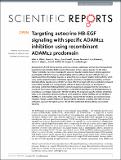| dc.contributor.author | Miller, Miles Aaron | |
| dc.contributor.author | Moss, Marcia L. | |
| dc.contributor.author | Powell, Gary | |
| dc.contributor.author | Petrovich, Robert | |
| dc.contributor.author | Edwards, Lori | |
| dc.contributor.author | Griffith, Linda G. | |
| dc.contributor.author | Lauffenburger, Douglas A. | |
| dc.contributor.author | Meyer, Aaron Samuel | |
| dc.date.accessioned | 2015-12-28T12:59:46Z | |
| dc.date.available | 2015-12-28T12:59:46Z | |
| dc.date.issued | 2015-10 | |
| dc.date.submitted | 2015-01 | |
| dc.identifier.issn | 2045-2322 | |
| dc.identifier.uri | http://hdl.handle.net/1721.1/100525 | |
| dc.description.abstract | Dysregulation of ErbB-family signaling underlies numerous pathologies and has been therapeutically targeted through inhibiting ErbB-receptors themselves or their cognate ligands. For the latter, “decoy” antibodies have been developed to sequester ligands including heparin-binding epidermal growth factor (HB-EGF); however, demonstrating sufficient efficacy has been difficult. Here, we hypothesized that this strategy depends on properties such as ligand-receptor binding affinity, which varies widely across the known ErbB-family ligands. Guided by computational modeling, we found that high-affinity ligands such as HB-EGF are more difficult to target with decoy antibodies compared to low-affinity ligands such as amphiregulin (AREG). To address this issue, we developed an alternative method for inhibiting HB-EGF activity by targeting its cleavage from the cell surface. In a model of the invasive disease endometriosis, we identified A Disintegrin and Metalloproteinase 12 (ADAM12) as a protease implicated in HB-EGF shedding. We designed a specific inhibitor of ADAM12 based on its recombinant prodomain (PA12), which selectively inhibits ADAM12 but not ADAM10 or ADAM17. In endometriotic cells, PA12 significantly reduced HB-EGF shedding and resultant cellular migration. Overall, specific inhibition of ligand shedding represents a possible alternative to decoy antibodies, especially for ligands such as HB-EGF that exhibit high binding affinity and localized signaling. | en_US |
| dc.description.sponsorship | National Institutes of Health (U.S.) (Grant R01-CA096504) | en_US |
| dc.description.sponsorship | National Institutes of Health (U.S.) (Grant U54-CA112967) | en_US |
| dc.language.iso | en_US | |
| dc.publisher | Nature Publishing Group | en_US |
| dc.relation.isversionof | http://dx.doi.org/10.1038/srep15150 | en_US |
| dc.rights | Creative Commons Attribution | en_US |
| dc.rights.uri | http://creativecommons.org/licenses/by/4.0/ | en_US |
| dc.source | Nature Publishing Group | en_US |
| dc.title | Targeting autocrine HB-EGF signaling with specific ADAM12 inhibition using recombinant ADAM12 prodomain | en_US |
| dc.type | Article | en_US |
| dc.identifier.citation | Miller, Miles A., Marcia L. Moss, Gary Powell, Robert Petrovich, Lori Edwards, Aaron S. Meyer, Linda G. Griffith, and Douglas A. Lauffenburger. “Targeting Autocrine HB-EGF Signaling with Specific ADAM12 Inhibition Using Recombinant ADAM12 Prodomain.” Scientific Reports 5 (October 19, 2015): 15150. | en_US |
| dc.contributor.department | Massachusetts Institute of Technology. Department of Biological Engineering | en_US |
| dc.contributor.department | Koch Institute for Integrative Cancer Research at MIT | en_US |
| dc.contributor.mitauthor | Miller, Miles Aaron | en_US |
| dc.contributor.mitauthor | Meyer, Aaron Samuel | en_US |
| dc.contributor.mitauthor | Griffith, Linda G. | en_US |
| dc.contributor.mitauthor | Lauffenburger, Douglas A. | en_US |
| dc.relation.journal | Scientific Reports | en_US |
| dc.eprint.version | Final published version | en_US |
| dc.type.uri | http://purl.org/eprint/type/JournalArticle | en_US |
| eprint.status | http://purl.org/eprint/status/PeerReviewed | en_US |
| dspace.orderedauthors | Miller, Miles A.; Moss, Marcia L.; Powell, Gary; Petrovich, Robert; Edwards, Lori; Meyer, Aaron S.; Griffith, Linda G.; Lauffenburger, Douglas A. | en_US |
| dc.identifier.orcid | https://orcid.org/0000-0002-1801-5548 | |
| dspace.mitauthor.error | true | |
| mit.license | PUBLISHER_CC | en_US |
| mit.metadata.status | Complete | |
